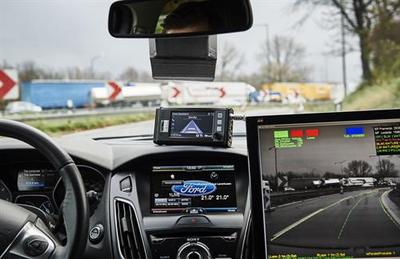New Ford Autonomous Tech Turns Traffic Jams into Chill Time +VIDEO
 New Ford Autonomous Tech Turns Traffic Jams into Chill Time |
- Ford is developing technology that could take some of the pain out of being in a traffic jam by reducing driver stress, improving traffic flow, and potentially helping to prevent accidents
- In congestion, the semi-autonomous technology Traffic Jam Assist increases comfort by assisting the driver with steering, braking and acceleration. Cars ahead and lane markings are monitored by camera and radar
- Ford also is developing technologies that assist drivers to stay centred in their lane, to continue in cruise control even after coming to a stop, and to park by remote control
AACHEN, GERMANY -- December 3, 2015: Being stuck in a traffic jam can be tiring, stressful and tedious. But that is exactly what drivers in Europe do for 30 hours every year on average.* Ford is currently developing a technology that could make driving in congestion less stressful.
Ford Traffic Jam Assist assists the driver by keeping the vehicle centred in the lane and brakes and accelerates to keep pace with the vehicle in front of it.** The system is among a range of semi-autonomous driver assistance technologies that Ford is developing.
Traffic Jam Assist, activated at the push of a button when a traffic jam is encountered, identifies the position of vehicles in front using a grille-mounted radar; and the location of lane markings using a front-facing camera behind the windscreen.
The driver can take over at any time by using the pedals, the steering wheel or the indicators. The system also regularly monitors the driver’s interaction with the steering wheel. If the system detects a lack of steering interaction, it will issue acoustic and visual warnings. Depending upon the vehicle speed and location, the frequency of warnings will vary. The driver is still required to monitor the driving environment and to be prepared to take control of the vehicle at any time.
“For many drivers, experiencing heavy traffic on the way to work can leave them stressed and angry, even before the work day begins. Traffic Jam Assist helps the driver maintain the distance to the vehicle ahead and helps to keep the vehicle centred in the lane. The system aims to reduce driver stress in dense,” said Reid Steiger, technical expert, Automated Driving, Ford of Europe.
This year Ford announced Ford Smart Mobility, the company’s plan to deliver the next level in connectivity, mobility, autonomous vehicles, the customer experience and big data, while making millions of people’s lives better.
A recent Ford-commissioned survey of 5,500 commuters in major European cities found that commuting by car to work can be more stressful than work itself. *** Further semi-autonomous technology systems that Ford is developing include technologies that help drivers stay centred in their lane, a cruise control system that enables drivers to easily resume their desired speed even after the vehicle has come to a complete stop, and a remote control parking system.
Easy cruising
Traffic Jam Assist is made possible by the combination of two technologies that are also in development, Adaptive Cruise Control with Stop & Go and Lane Centering Aid.
At the push of a button, Adaptive Cruise Control with Stop & Go is designed to utilise radar and camera information to detect the location and distance of vehicles ahead. It reduces the speed for slower vehicles andthen resumes the desired speed when traffic clears. The operating range now enables drivers to easily resume their speed after a complete halt. **
Lane Centering Aid
assists the driver to keep the vehicle centeredin its lane. The technology
builds on Ford’s existing
Lane Keeping Aid
technology.
Remote parking
Remote Park Assist builds on Active Park Assist, available on current Ford vehicles, and Fully Assisted Parking Aid, the next-generation parking technology, which controls steering, gear selection and forward and reverse motion to facilitate push-button parking.
Vehicle sizes have increased by up to 25 per cent over the last 40 years, while in many cases garages and parking spaces have remained constant.****
Remote Park Assist will enable drivers to park perpendicularly in narrow garages and crowded underground parking garages without being in the vehicle, helping to optimise parking spaces in ever-more crowded urban areas. For example, the technology could help parents who sometimes struggle to help young ones out of the car after parking in a tight parking space adjacent to other vehicles. Using a special key fob, the driver will be able to remotely start the engine and shift gears, from a better vantage point, standing near the vehicle. **


